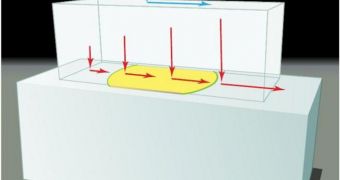According to a new scientific study, it would appear that the most basic laws of introductory physics do not hold up to scientific scrutiny, as evidenced by lab bench models of how earthquakes are produced.
Investigations such as this have huge potential, in the sense that they could provide new insight for improving materials science and engineering.
Additionally, conclusions from such studies could be used by planetary scientists and geologists to try and make sense of the natural phenomena that combine to trigger devastating tremors.
Better prediction methods could then be developed to defend against the quakes, and such timely measures could help save hundreds of thousands of lives.
“Our group has recently devised a way to look at laboratory generated earthquakes as they take place,” explains expert Jay Fineberg, quoted by Wired.
“On the way, we found out that many of the assumptions people have used historically in investigating this stuff […] are basically wrong. They don’t work,” adds the physicist, who is based at the Hebrew University of Jerusalem.
The new investigation focused on testing a basic law of physics stating the the amount of force needed to make a book start sliding on a surface is equal to the force of friction keeping it in place.
The coefficient of friction is a number that dictates the intensity of the force of friction. This concept can be defined as the ratio between the forces pushing sideways and those pushing down.
This law has been taught in introductory physics lessons around the world for many decades.
But when Oded Ben-David, one of Fineberg's students, attempted to reproduce the theory in a controlled lab experiment, the law broke down.
Ben-David says that he had to apply as much as five times more sideway force than the theory predicted in order to get the book to move.
The student is the first author of a new paper detailing the findings, which appears in the October 8 issue of the top journal Science.
“Even in the lab, he couldn’t predict what was going to happen. Small, crazy details made a really big difference,” Fineberg says of the investigation .
Experts say that the dynamics of the interactions between two objects sliding past each other are changed by the smallest of factors.
One example for this is that two flat bodies do not make contact throughout their length, but rather only on several hundreds of small contact point, that are basically irregularities in the material.
“These [test] blocks are optically flat, we spent thousands of dollars to make them that way. Even then, small nuances entirely change the dynamics of what we’re going to see,” Fineberg says.
“If this is in a lab experiment, imagine what happens along an earthquake fault, which is a really crappy experimental system,” he goes on to say.
“I think one of the most exciting things about this paper is the fact that they see a whole range of behaviors in one system,” explains Penn State University geophysicist Chris Marone.
“People had seen different parts of this in different experiments in different configurations. But this is one of the first, if not the first time that people have seen all the different ranges of behaviors in one place,” he adds.
Marone was not a part of the investigation.

 14 DAY TRIAL //
14 DAY TRIAL //